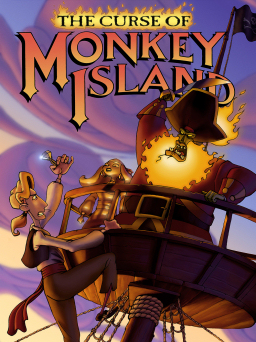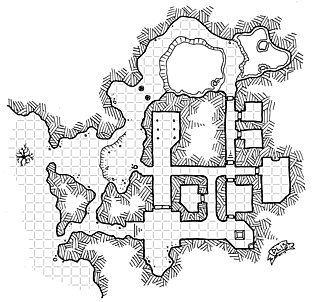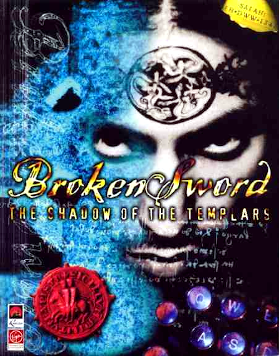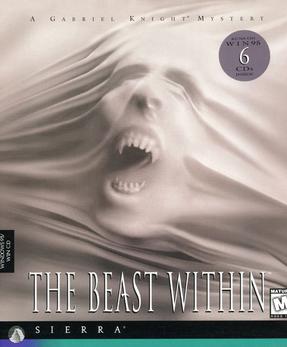Related Research Articles

The Curse of Monkey Island is an adventure game developed and published by LucasArts in 1997. A sequel to 1991's Monkey Island 2: LeChuck's Revenge, it is the third game in the Monkey Island series.

King's Quest is a graphic adventure game series, released between 1980 and 2016 and created by the American software company Sierra Entertainment. It is widely considered a classic series from the golden era of adventure games. Following the success of its first installments, the series was primarily responsible for building the reputation of Sierra. Roberta Williams, co-founder and former co-owner of Sierra, designed all of the King's Quest games until the series' reboot in 2015.

Roberta Lynn Williams is an American video game designer and writer, who co-founded Sierra On-Line with her husband, game developer Ken Williams. In 1980, her first game, Mystery House, became a modest commercial success; it is credited as the first graphic adventure game. She is also known for creating and maintaining the King's Quest series, as well as designing the full motion video game Phantasmagoria in 1995.
Gabriel Knight is a series of point-and-click adventure games released by Sierra On-Line in the 1990s created by Jane Jensen. The titular character is an author and book store owner in New Orleans who is investigating a strange series of murders when he learns he is descended from a long line of Schattenjäger. After undergoing a spiritual trial, Gabriel becomes the new Schattenjäger, called on to stop those who use supernatural methods to threaten others. To signify this, he wears the Ritter Talisman, a protective medallion. Not having supernatural abilities himself, Gabriel mainly opposes his enemies with cunning and insight after investigation and research. In the first game, he is assisted by Grace Nakimura. In the two sequels, the two act as partners against evil, with Grace being a playable character.
Broken Sword is a series of adventure games. The first game in the series, Broken Sword: The Shadow of the Templars, was released and developed in 1996 by British developer Revolution Software. Its sequel, Broken Sword II: The Smoking Mirror, was released a year later, and was followed by Broken Sword: The Sleeping Dragon in 2003, Broken Sword: The Angel of Death in 2006, and Broken Sword 5: The Serpent's Curse in 2013. A remake of the first game in the series, known as Broken Sword: Shadow of the Templars – The Director's Cut, was released in 2009, and a remake of the second game in the series, Broken Sword: The Smoking Mirror – Remastered, in 2010 for iOS devices; other platforms followed in 2011.
Jane Jensen is an American video game designer and author. She is mostly known as the creator of the Gabriel Knight series of adventure games, and also co-founded Oberon Media and Pinkerton Road video game development companies. Jensen also writes under the name Eli Easton.

A dungeon crawl is a type of scenario in fantasy role-playing games (RPGs) in which heroes navigate a labyrinth environment, battling various monsters, avoiding traps, solving puzzles, and looting any treasure they may find. Video games and board games which predominantly feature dungeon crawl elements are considered to be a genre.

King's Quest VI: Heir Today, Gone Tomorrow is a point-and-click adventure game, first released in 1992 as the sixth installment in the King's Quest series produced by Sierra On-Line. Written by Roberta Williams and Jane Jensen, King's Quest VI is widely recognized as the high point in the series for its landmark 3D graphic introduction movie and professional voice acting. King's Quest VI was programmed in Sierra's Creative Interpreter and was the last King's Quest game to be released on floppy disk. A CD-ROM version of the game was released in 1993, including more character voices, a slightly different opening movie and more detailed artwork and animation.
An action role-playing game is a subgenre of video games that combines core elements from both the action game and role-playing genre.

Broken Sword: The Shadow of the Templars is a 1996 point-and-click adventure game developed by Revolution Software. It is the first in the Broken Sword series, co-written and directed by Charles Cecil. The player assumes the role of George Stobbart, an American tourist in Paris, as he attempts to unravel a deep conspiracy involving a sinister cult and a hidden treasure, seeing him travel to various locations around Europe and the Middle East. The game's storyline was conceived to feature a serious tone and heavily influenced by research on Knights Templar by Cecil, but was also interlaced with humor and graphics in the style of classic animated films.

The Beast Within: A Gabriel Knight Mystery is an interactive movie point-and-click adventure game, developed and published by Sierra On-Line for MS-DOS, Macintosh, and Microsoft Windows, and released in 1995. The live-action scenes star the talents of Dean Erickson and Joanne Takahashi in the game's lead roles. The sequel to 1993's Gabriel Knight: Sins of the Fathers and the second entry in the Gabriel Knight series, the game focuses on the lives of Gabriel Knight, an author who is descended from a family that combats supernatural evils, and Grace Nakimura, a student who assists Gabriel, as they become involved in a new case within Germany that focuses around a werewolf that has begun killing people around the city of Munich, and has connections to the lives of two famous people of Germany's history.

Gabriel Knight 3: Blood of the Sacred, Blood of the Damned is a point-and-click adventure game, developed and published by Sierra Studios for Microsoft Windows, and released in 1999. The sequel to 1995's The Beast Within: A Gabriel Knight Mystery and the third title in the Gabriel Knight series, the game's story focuses on the lives of Gabriel Knight, an author who is descended from a family that combats supernatural evils, and Grace Nakimura, a student who assists Gabriel, as they become engaged in a case that involves tracking down a kidnapped infant by vampires that is connected to the Holy Grail and Jesus. The setting is based on a real-life conspiracy theory about a hidden treasure, and involves elements of history and myths surrounding the Grail, vampires, and the Knights Templar.

Gabriel Knight: Sins of the Fathers is a 1993 point-and-click adventure game, developed and published by Sierra On-Line for MS-DOS, Macintosh, and Windows, and released on December 17, 1993. The CD-ROM version features the voice talents of Tim Curry, Mark Hamill, Michael Dorn, Efrem Zimbalist Jr., and Leah Remini. The game's story focuses on Gabriel Knight, a struggling novelist and owner of a rare book store in New Orleans, who opts to research a recent spate of murders around the city that have a connection to voodoo. In the process, he is slowly revealed to be a descendant of a German family who are involved in combatting people who use supernatural forces, and discovers a link between the killings and his family's past.

Dracula 3: The Path of the Dragon is a 2008 point-and-click adventure video game developed by Kheops Studio for Microsoft Windows, and published by MC2 France under their Microïds label in Europe and Encore in North America. In 2010, an abridged version of the game developed by Tetraedge Games and published by Chillingo was released in a three-part episodic form for iOS. The full version of the game was ported to OS X in 2010, published by Coladia. Also in 2010, the three-part iOS version was made available for PC as the Dracula Series. In 2014, the abridged iOS version was made available as a single game on Steam.

Dracula: Resurrection is a 1999 graphic adventure video game developed by Index+. Set in 1904 Transylvania, the game serves as a follow-up to Bram Stoker's novel Dracula. Seven years after the death of Count Dracula, Jonathan Harker's wife Mina finds herself mysteriously drawn back to Transylvania. Jonathan subsequently travels to Borgo Pass in an effort to rescue her. The player assumes the role of Jonathan and uses a point-and-click interface to solve puzzles and navigate the game's world, often with the help of an object called the Dragon Ring.

Gray Matter is a point-and-click adventure game designed by Jane Jensen, creator of the Sierra Entertainment Gabriel Knight series. The game was developed by Wizarbox and published by DTP Entertainment for Microsoft Windows and Xbox 360. It was released in November 2010 in Continental Europe and in English-speaking territories in 2011.
An adventure game is a video game genre in which the player assumes the role of a protagonist in an interactive story, driven by exploration and/or puzzle-solving. The genre's focus on story allows it to draw heavily from other narrative-based media, such as literature and film, encompassing a wide variety of genres. Most adventure games are designed for a single player, since the emphasis on story and character makes multiplayer design difficult. Colossal Cave Adventure is identified by Rick Adams as the first such adventure game, first released in 1976, while other notable adventure game series include Zork, King's Quest, Monkey Island, Syberia, and Myst.

Pinkerton Road Studio is an American video game developer based in Mount Joy, Pennsylvania. The company is responsible for creating Moebius: Empire Rising and the remake of Gabriel Knight: Sins of the Fathers. Jane Jensen, the creator behind the Gabriel Knight: Sins of the Fathers and Gray Matter, established Pinkerton Road Studio in 2012 along with Robert Holmes to focus on graphic adventure games.

The "cat hair mustache puzzle" is a colloquial name given to a puzzle in the 1999 adventure game Gabriel Knight 3: Blood of the Sacred, Blood of the Damned. The puzzle involves disguising the protagonist Gabriel Knight with hair from a cat, in order to steal a man's motorcycle rental. It was created by the game's producer, Steven Hill, following a puzzle being worked on by the game's lead designer, Jane Jensen, having to be cut due to budgetary reasons. The designers disliked the puzzle, but because of time constraints, it had to be left in.
References
- 1 2 Craddock, David L. (November 20, 2015). "Hunting Shadows: The Making of Gabriel Knight – Chapter 5". Episodic Content. Archived from the original on May 13, 2020. Retrieved July 5, 2020.
- 1 2 Ravipinto, Dan (January 30, 2004). "Gabriel Knight 3". Adventure Gamers. Archived from the original on April 28, 2017. Retrieved July 5, 2020.
- 1 2 3 Salter, Anastasia (2017). Jane Jensen: Gabriel Knight, Adventure Games, Hidden Objects - Influential Video Game Designers. Bloomsbury Publishing USA. ISBN 1501327453. Archived from the original on July 15, 2021. Retrieved July 5, 2020.
- ↑ Allin, Jack (May 26, 2008). "Jane Jensen". Adventure Gamers. Archived from the original on July 15, 2019. Retrieved July 5, 2020.
- ↑ Bronstring, Marek (May 23, 2003). "Project Jane-J". Adventure Gamers. Archived from the original on May 7, 2017. Retrieved July 5, 2020.
- ↑ Koncewicz, Radek (January 24, 2010). "Deductive Puzzles and Bulletin Boards". Gamasutra . Archived from the original on May 15, 2014. Retrieved July 5, 2020.
- ↑ Allin, Jack (February 14, 2013). "If Not Puzzles… What?". Adventure Gamers. Archived from the original on March 25, 2020. Retrieved July 5, 2020.
- ↑ "Gabriel Knight 3". Edge . No. 36.
- ↑ "Throwback Thursday: Culpa Innata". Just Adventure. June 18, 2015. Archived from the original on July 15, 2021. Retrieved July 5, 2020.
- ↑ "Top 100 All-Time Adventure Games". Adventure Gamers. December 30, 2011. Archived from the original on July 15, 2021. Retrieved July 5, 2020.
- ↑ Dickens, Evan (February 25, 2004). "Underground Awards". Adventure Gamers. Archived from the original on July 17, 2016. Retrieved July 5, 2020.
- ↑ Walter, Johann (November 21, 2006). "Destination: Treasure Island hands-on archived preview". Adventure Gamers. Archived from the original on July 10, 2019. Retrieved July 5, 2020.
- ↑ "1999 - Gabriel Knight 3: Il Mistero Macchiato". The Games Machine. No. 6. March 2008.
- ↑ "Gabriel Knight 3". Computer Gaming World. No. 179. June 1999.
- ↑ Kalata, Kurt (November 22, 2010). "Gabriel Knight 3: Blood of the Sacred, Blood of the Damned". Hardcore Gaming 101. Archived from the original on December 5, 2019. Retrieved July 5, 2020.
- ↑ Mostabilini, Andrea (July 15, 2011). "Book Review: The Guide to Classic Graphic Adventures". Adventure Gamers. Archived from the original on March 11, 2017. Retrieved July 5, 2020.